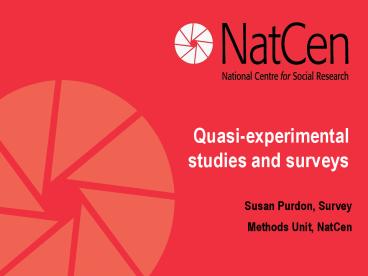Quasiexperimental studies and surveys - PowerPoint PPT Presentation
1 / 10
Title:
Quasiexperimental studies and surveys
Description:
Sustained, and possibly increasing, use of quasi-experiments ... Feature of most quasi-experiments is that they are data-hungry (large sample ... – PowerPoint PPT presentation
Number of Views:102
Avg rating:3.0/5.0
Title: Quasiexperimental studies and surveys
1
Quasi-experimental studies and surveys
Susan Purdon, Survey Methods Unit, NatCen
2
Scope
- Trends in policy impact evaluation
- Associated trends in the use of data
- Some challenges
- Some possible options for future development
3
Trends in policy impact evaluation in GB
- No clear trend in RCTs
- Sustained, and possibly increasing, use of
quasi-experiments - Typically outcomes for programme participants or
eligibles are compared to outcomes for a
comparison group. Difference between the groups
after controlling for confounders is taken as the
impact of the programme - Feature of most quasi-experiments is that they
are data-hungry (large sample sizes many
variables)
4
Using admin data for quasi-experiments
- Advantages of using admin data (rather than
bespoke survey data) are well-recognised - Large sample sizes inexpensive minimal
non-response bias (except where consent is
needed) - Examples include the longer-term impacts of NDLP
- But not always possible
- Wrong outcome measures
- Confounders missing
- Issues around identifying the eligible pop
5
Using survey data as an alternative
- Existing survey datasets are sometimes used (e.g
LFS MCS). - But often a combined problem of smaller sample
sizes and lack of all necessary variables rules
it out - More usual model is bespoke survey data
collection - Advantages
- Focus on eligible population
- Identification of a suitable comparison group
- Appropriate primary and secondary outcomes
- Full data on confounders
6
Examples
- Early education pilots for Two Year Old Children.
- Before-after interviews with c.1400 users of
childcare and a similar number of comparison
group interviews. Tested whether child cognitive
development in the pilots exceeded that for the
comparison group - Evaluation of the Free School Meals pilots
- Involves tracking diets of school children in
pilot areas v. diets in comparison areas
7
Challenges raised
- Impacts tend to be modest, so large sample sizes
needed - But surveys are v.expensive, esp for face-to-face
interviews - Budgets limited, and appear to be decreasing
- So the future not clear. Options include
- Cheaper survey methods (e.g postal)
- More focussed evaluations just on those where
impact is likely to be greatest
8
Possible options for research community
- Increase the pressure for RCTs (which often need
less data) - Press for larger (or at least maintained) budgets
- Press for policies that can sensibly be evaluated
- Improve knowledge base so that evaluation designs
are optimal
9
Improving knowledge base
- Better understanding of how to use surveys to
control for self-selection bias - Better understanding of how to minimise mean
square error (standard error bias) - Better understanding of how to combine survey and
admin data approaches
10
(No Transcript)

